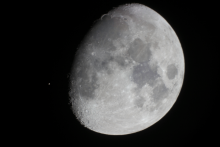Listen to today's episode of StarDate on the web the same day it airs in high-quality streaming audio without any extra ads or announcements. Choose a $8 one-month pass, or listen every day for a year for just $30.
You are here
Moon and Aldebaran
One of the most famous depictions of the night sky is “Starry Night,” a painting by Vincent Van Gogh. It depicts the Moon and stars as whorls of light and color.
Unfortunately, the real night sky is a lot less dramatic. In fact, there’s little color to be seen at all — almost everything is black and white.
If you look carefully, though, you can find some exceptions. A few stars look blue, a few look yellow, and a few look orange or red. That includes Aldebaran, the eye of Taurus the bull, which stands to the lower left of the Moon at nightfall.
A star’s color tells you its surface temperature. Blue stars are the hottest — tens of thousands of degrees hotter than the Sun. White and yellow stars are in the middle, while orange and red stars are the coolest — up to a few thousand degrees cooler than the Sun.
All of the orange and red stars that are visible to the unaided eye shine that color because of their size — they’re much bigger than the Sun. They’ve used up the hydrogen fuel in their cores, causing their outer layers to expand. That makes them cooler — and redder.
Aldebaran itself is more than 40 times the diameter of the Sun. In the distant future, it’ll get even bigger, which will make it much brighter, and even redder than it is now. Eventually, though, Aldebaran’s outer layers will puff away into space, leaving only its hot but dead core — closing the bull’s ruddy eye.
Tomorrow: our galactic neighborhood.
Script by Damond Benningfield




